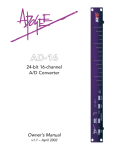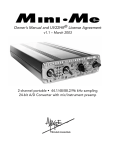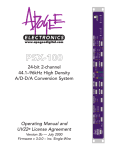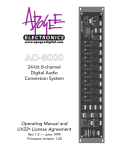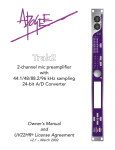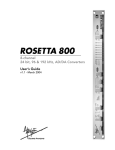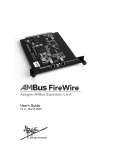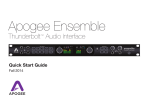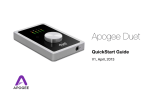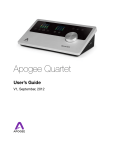Download Apogee DA-16 Owner`s manual
Transcript
DA-16 24-bit 16-channel D/A Converter Owner’s Manual v1.0 – September 2001 Apogee DA-16 User’s Guide Written by David Kimm and Julio Alvarez. Production, editing and running round in circles by Richard Elen, with valuable assistance from Seth Reinhart. Apogee is a Registered Trademark of Apogee Electronics Corporation. All other trademarks are property of their respective holders. Technology within the DA-16 may be covered by one or more patents that are the property of Apogee Electronics Corporation. Infringement of said patents or any relevant other naughty things may result in one or more uncomfortable and potentially financially-damaging encounters with members of the legal profession. Registered User Customer Support: For customer support, please call (310) 915-1000 and ask for Tech Support, or email [email protected]. Technical Support is available to registered owners. Features and specifications subject to change without notice. © 2001 APOGEE ELECTRONICS CORPORATION 3145 Donald Douglas Loop South Santa Monica, California 90405-3210 USA Tel: +1 310/915-1000 Fax: +1 310/391-6262 Email: [email protected] Web: http://www.apogeedigital.com/ This manual is copyright ©2001 by APOGEE ELECTRONICS CORPORATION. All rights reserved. Under copyright laws, this manual may not be duplicated in whole or in part without the written consent of Apogee. Just drop us an email and tell us why you need to copy it. Page 2 Apogee DA-16 User’s Guide DA-16 24-bit 16-channel D/A Converter Owner’s Manual v1.0 – September 2001 Apogee DA-16 User’s Guide Warnings CAUTION: To reduce the risk of electrical shock, do not remove the cover. No user serviceable parts inside; refer servicing to qualified personnel. To change the operating voltage or change the firmware EPROM, it is necessary to remove the cover of the unit. As a result, such operations must be carried out only by technicallyqualified personnel. WARNING: To reduce the risk of fire or electrical shock, do not expose this appliance to rain or moisture. This symbol, wherever it appears, alerts you to the presence of uninsulated dangerous voltage inside the enclosure—voltage that may be sufficient to constitute a risk of shock. Operations indicated with this symbol should be carried out only by technically-qualified personnel. This symbol, wherever it appears, alerts you to important operating and maintenance instructions in the accompanying literature. Read the manual. Environmental warnings • • • • • • • • • Never touch the AC plug with wet hands. Do not use this unit in damp areas or near water. Avoid damaging the AC plug or cord and potentially causing a shock hazard. If liquids spill into or onto the DA-16, disconnect the power and return to your dealer for servicing. This unit should only be connected to an AC power supply of the correct voltage. Check with your dealer if in doubt. Precautions should be taken so that the grounding or polarization of the AC power is not defeated. Unplug the AC cord when the unit is unused for long periods of time. This unit should only be cleaned as recommended by the manufacturer, or damage to the finish may result. To avoid potential damage to your unit, only use in areas where proper ventilation and moderate temperatures are assured. Power warning AC voltage ratings for electrical power vary from area to area. Severe damage to your unit is possible if your DA-16 is configured incorrectly for your local power. If in doubt, consult an Apogee dealer. A label adjacent to the power connector indicates the voltage to which the unit was set on leaving the factory. Instructions for changing the power input voltage are provided. We strongly advise you to check that the voltage label remains current and is updated if the input voltage setting is changed. FCC warning This equipment has been tested and found to comply with the limits for a Class A digital device, pursuant to Part 15 of the FCC rules. These limits are designed to provide reasonable protection against harmful interference when operated in a commercial environment. This equipment generates, uses, and can radiate radio frequency energy and, if not installed and used in accordance with the instruction manual, may cause harmful interference to radio communications. Operation of this equipment in a residential area is likely to cause harmful interference, in which case the user will be required to take whatever measures may be required to correct the interference at his own expense. Copyright Notice The Apogee DA-16 is a computer-based device, and as such contains and uses software in ROMs. This software, and all related documentation, including this Owner’s Manual, contain proprietary information which is protected by copyright laws. All rights are reserved. No part of the software and its related documentation may be copied, transferred, or modified. You may not modify, adapt, translate, lease, distribute, resell for profit or create derivative works based on the software and its related documentation or any part thereof without prior written consent from Apogee Electronics Corporation, U.S.A. Page 4 Apogee DA-16 User’s Guide Registration and Warranty Information Be sure to register your DA-16, either by filling in the enclosed Registration Card or by completing the on-line registration form at our Web site: http://www.apogeedigital.com/register.html. If you do so, Apogee can contact you with any update information. As enhancements and upgrades are developed, you will be contacted at the registration address. Firmware updates are free for the first year of ownership unless otherwise stated. Please address any inquiries to your dealer or directly to Apogee at: APOGEE ELECTRONICS CORPORATION, 3145 Donald Douglas Loop South, Santa Monica, CA 90405, USA. TEL: (310) 915-1000, FAX: (310) 391-6262 email: [email protected]. Web: http://www.apogeedigital.com/ APOGEE ELECTRONICS CORPORATION warrants this product to be free of defects in material and manufacture under normal use for a period of 12 months. The term of this warranty begins on the date of sale to the purchaser. Units returned for warranty repair to Apogee or an authorized Apogee warranty repair facility will be repaired or replaced at the manufacturer’s option, free of charge. All units returned to Apogee or an authorized Apogee repair facility must be prepaid, insured and properly packaged. Apogee reserves the right to change or improve design at any time without prior notice. Design changes are not implemented retrospectively, and the incorporation of design changes into future units does not imply the availability of an upgrade to existing units. This warranty is void if Apogee determines, in its sole business judgment, the defect to be the result of abuse, neglect, alteration or attempted repair by unauthorized personnel. The warranties set forth above are in lieu of all other warranties, expressed or implied, and Apogee specifically disclaims any and all implied warranty of merchantability or of fitness for a particular purpose. The buyer acknowledges and agrees that in no event shall the company be held liable for any special, indirect, incidental or consequential damages, or for injury, loss or damage sustained by any person or property, that may result from this product failing to operate correctly at any time. USA: Some states do not allow for the exclusion or limitation of implied warranties or liability for incidental or consequential damage, so the above exclusion may not apply to you. This warranty gives you specific legal rights, and you may have other rights which vary from state to state. Service Information If the DA-16 is kept in a clean environment free of excess dust, moisture and heat, it will give years of trouble-free service. The DA-16 contains no user-serviceable components: refer to qualified service personnel for repair or upgrade. Your warranty will be voided if you tamper with the internal components. If you have any questions with regard to the above, please contact Apogee. In the event your DA-16 needs to be upgraded or repaired, it is necessary to contact Apogee prior to shipping, and a Return Materials Authorization (RMA) number will be assigned. This number will serve as a reference for you and helps facilitate and expedite the return process. Apogee requires that shipments be pre-paid and insured — unless otherwise authorized in advance. IMPORTANT: Any shipment that is not pre-paid or is sent without an RMA number will not be accepted. Page 5 Apogee DA-16 User’s Guide Declarations of Conformity Declaration of Conformity—FCC Apogee DA-16 This device complies with Part 15 of the FCC Rules. Operation is subject to the following two conditions: (1) This device may not cause harmful interference, and (2) This device must accept any interference received, including interference that may cause undesired operation. This equipment has been tested and found to comply with the limits of a Class B digital device, pursuant to Part 15 of the FCC Rules. These limits are designed to provide reasonable protection against harmful inteference in a residential installation. This equipment generates, uses and can radiate radio frequency energy and, if not installed and used in accordance with the instructions, may cause harmful interference to radio communications. If this equipment does cause harmful interference to radio or television reception, which can be determined by turning the equipment off and on, the user is encouraged to try to correct the interference by one or more of the following measures: 1. Re-orient or relocate the receiving antenna. 2. Increase the separation between the equipment and receiver. 3. Connect the equipment into an outlet on a different circuit from that to which the receiver is connected. 4. Consult the dealer or an experienced radio/TV technician for help. NOTE: The use of non-shielded cable with this equipment is prohibited. CAUTION: Changes or modifications not expressly approved by the manufacturer responsible for compliance could void the user’s authority to operate the equipment. Apogee Electronics Corporation, 3145 Donald Douglas Loop South, Santa Monica, CA 90405. Betty Bennett, CEO. Industry Canada Notice This Class B digital apparatus meets all requirements of the Canadian Interference-Causing Equipment Regulations. Cet appareil numérique de la classe B respecte toutes les exigences du Règlement sur le matérial brouilleur du Canada. Declaration of Conformity – CE Apogee Electronics Corporation hereby declares that the product, the DA-16, to which this declaration relates, is in material conformity with the following standards or other normative documents: • EN50081-1/EN55022; 1995 • EN50082-1/IEC 801-2, 3, 4; 1992 following the provisions of: • 73/23/EEC – Low Voltage Directive • 89/336/EEC – EMC Directive Declaration of Conformity – Japan Apogee Electronics Corporation hereby declares that the DA-16, to which this declaration relates, is in material conformity with the VCCI Class A standard. Declaration of Conformity – Australia Apogee Electronics Corporation hereby declares that the DA-16 is in material conformity with AN/NZS standard requirements. Page 6 Apogee DA-16 User’s Guide CAUTION Any changes or modifications not expressly approved by APOGEE ELECTRONICS CORPORATION could void your authority to operate this equipment under the FCC rules. OWNER’S RECORD The serial number is located on the rear panel of the unit. We suggest you record the serial number in the space provided below. Refer to it whenever you call an authorized Apogee Electronics repair facility or the manufacturer. Please be sure to return your completed warranty card immediately! DA-16 Serial No. ________________ Purchase Date __________________ Factory Firmware Revision ________________ Dealer____________________________________________________ Phone ____________________________________________________ Address ___________________________________________________ User’s Installation Notes Space left blank for user tracking of factory modifications, option installations, software upgrades, manual revisions/ addenda, internal settings. Page 7 Apogee DA-16 User’s Guide About This Manual This manual was written to help you to use this product to its fullest potential. Although the DA-16 is inherently simple to operate, it may contain features that may not be obvious from the front panel. Therefore, reading this manual is recommended to unlock the full value of this product. This manual was also written to prevent misuse of this product. Should you run into a problem when operating the DA-16, the solution is hopefully contained in the following pages. We expect that this manual will serve as the basis of your diagnosis of problems encountered and hope it will be used as such prior to any calls to technical support at Apogee. Remember — before calling technical support at Apogee, you should register this product either by sending in the registration card or by registering on the Apogee Web site (http://www.apogeedigital.com). The technical support specialist will refer to the manual during your call and will expect that you have read it and understand the product to some degree. If you have any suggestions on how to improve this owner’s manual, please forward them to us at [email protected] or fax them to +1-310-391-6262. Page 8 Apogee DA-16 User’s Guide Table of Contents Warnings ...........................................................................................................................4 Registration & Warranty Information ...............................................................................5 Service Information...........................................................................................................5 Declarations of Conformity...............................................................................................6 Owner’s record .................................................................................................................7 User’s Installation Notes ...................................................................................................8 About This Manual ............................................................................................................8 The Manual Table of Contents..............................................................................................................9 Introduction ....................................................................................................................11 Controls, Connections and Operation ............................................................................11 Power Sync/Channel Set Sample Rate ....................................................................................................................................................12 Channel bank selector Status and level LEDs .....................................................................................................................................13 The Rear Panel ................................................................................................................13 DIP switches Word Clock In AES Input pinout ADAT Optical Inputs .......................................................................................................................................14 TDIF Connectors Analog Pinout Calibration Mode ............................................................................................................15 Procedure Restoring Default Values Internal Adjustments ......................................................................................................15 Voltage Selector Fuses DA-16 Specifications .......................................................................................................16 Page 9 Apogee DA-16 User’s Guide This page intentionally left blank. Page 10 Apogee DA-16 User’s Guide Introduction Congratulations! You have just purchased a powerful and flexible multichannel digital-to-analog converter that renders an accurate soundstage and pristine audio quality in the tradition of Apogee’s award-winning converters. While the DA-16 is simple in operation, you should take a moment to read over this manual in order to get acquainted with the DA-16’s features and operation. Designed for the latest hard-disk recording systems, the DA-16 “IntelliDAC” offers 16 channels of Apogee quality at an exceptionally affordable price, handling 24-bit D/A conversion at sample rates up to 96 kHz. The converters can source their digital input from either AES/EBU, ADAT optical or TDIF sources, and the unit can then sync to word clock or a specified input. ADAT and TDIF inputs are organized into two groups of eight, and channels 1-8 and 9-16 can have different sources. In addition, the light-pipe inputs accept the Sonorus S/MUX protocol for sample-splitting high-resolution signals into optical interfaces, allowing access to all 16 channels – the first time this protocol has been included on an Apogee converter. The input sample rate is detected automatically, and a two-level “Lock” indicator shows “wide” (up to ±150 degrees) and “narrow” (5 degrees) lock. LEDs indicate signal status on each channel, with the LED intensity modulated by the signal level to give an “analog-like” display. The balanced analog outputs are supplied in groups of eight channels on 25-pin D connectors, in keeping with other Apogee D/A conversion systems using these connectors (the pinout is the same as on Tascam systems). The subtitle “IntelliDAC” relates to the converter’s unique “intelligent” two-stage re-clocking system, a first for Apogee. Apogee converters have traditionally excelled at removing jitter from the incoming clock signal, but for extremely jittery input sources, more control is needed. The DA-16 solves this problem by utilizing two clocks. A fast-responding “read” clock, with a wide locking range, fills a dedicated FIFO buffer, while an ultralow-jitter 'write' clock writes the data out of the buffer, and is used to clock the converters. The advantage of this configuration is that both incoming clock and data are de-jittered. In addition, the system is less sensitive to phase errors between synchronous digital sources. Errors up to plus or minus 150 degrees can be corrected, substantially reducing the chances of glitching, and enabling the DAC to offer superior performance even when the input signal is extremely unstable. Controls, Connections and Operation The Front Panel POWER On the left-hand side of the front-panel is the POWER button. Press once to power the unit on and press again to power off the unit. SYNC/CHANNEL SET To the right of the power button is the SYNC (momentary press)/CH SET (press & hold) button. This button has two functions: The SYNC function works in conjunction with the CH 1-8 and CH 9-16 buttons, allowing you to select the bank of input channels (1-8, 9-16, or WORD CLOCK) used to synchronize the DA-16. Using the SYNC button, select the sync source from either the bank 1 audio source, the bank 2 audio source, or the Word clock input on the rear panel. For example, let’s say you have an ADAT connected to optical input 1-8 and a DA-88 connected to TDIF input 9-16 and you want the DA-16 to clock to the ADAT. You would select ‘OPTICAL’ using the CH 1-8 button and ‘TDIF’ using CH 9-16 button. Then you would select ‘CH1-8’ using the SYNC button. The DA-16 would automatically lock to the sample rate of the incoming ADAT signal. In this scenario, if both recorders are to be Page 11 Apogee DA-16 User’s Guide played simultaneously through the DA-16, you would probably want to synchronize the DA-88 using word clock from a BRC so that you don’t end up with two asynchronous sources. The second function of this button is to select the channel(s) to calibrate in Calibration Mode (page 15). SAMPLE RATE To the right of the SYNC button is the SAMPLE RATE indicator. The yellow LEDs indicate the incoming sample rate from the source selected using the SYNC and CH 1-8/9-16 buttons. The incoming sample rate is automatically detected, and thus does not need to be user-selectable on the DA-16. While the DA16 is in S/MUX mode, the correct sample rates of 88.2 kHz and 96 kHz will be displayed. The DA16’s clock is designed to lock to incoming sample rates in the range of 44.1 kHz to 96 kHz, ±10%. This accommodates all pull-up and pull-down sample rates within this range as well as pitch-shifted and other irregular rates. Below the sample rate indicators is the green WIDE lock indicator. When lit, this LED shows that the unit has achieved WIDE lock (up to ± 150 degrees phase error). With all but the most extremely jittery input signals, this LED should light quickly when the DA-16 is fed an input signal. The red NARROW LED illuminates when the unit has achieved a tighter lock (less than ±5 degrees phase error). Again, this LED should illuminate fairly quickly after WIDE lock is achieved. The DA-16’s normal functional state is with both NARROW and WIDE LEDs illuminated. If the NARROW LED fails to light, check the quality of your incoming signal and make sure that the DA-16’s SYNC and CH source selections are set correctly. The DA-16 will lock to signals with large amounts of jitter and/or phase errors. However, it is always worth trying to locate the source of errors of this type. When selecting ‘AES’ as a digital source and the sync source, individual channel pairs (1/2, 3/4, 5/6, etc.) can be selected as the sync source using the DIP switches on the rear-panel. Thus, for example, if you have several DAT players connected to the AES D-sub connector on the rear panel, you can select one of them as the DA-16’s sync source. NOTE: While the DA-16 has Word Clock selected as its sync source, AND the S/MUX dip switch is in the ON position, AND one of the banks is selected as Optical, then the DA-16 will enter S/MUX mode and correspondingly indicate 88.2 or 96 kHz sample rates. If you do not wish to engage S/MUX mode in this situation, simply turn the S/MUX mode DIP switch to the OFF position, or select an input source other than Optical on the unused bank. CH 1-8 and CH 9-16 These buttons select the appropriate input for each set of 8 channels – AES, TDIF, or ADAT (Normal or SMUX mode). The CH 1-8 and CH 9-16 buttons select the incoming digital source for the respective channel bank. The DOWN and UP markings above these buttons come into play in the level calibration mode and work in conjunction with the ‘CH SET’ marking above the SYNC button. Indicators There is an LED indicator for each button selection as well as for each audio channel. Each sample frequency has its own LED, in addition to WIDE LOCK and NARROW LOCK. When a sync source is selected, wide lock will establish first when the PLL has locked to within approximately ±150 degrees. The 2-stage re-clocking buffer will insure that no audio data is lost while wide lock is fully indicated. After wide lock is established, the PLL will adjust its phase relationship to the sync source until narrow lock is established. If narrow lock cannot be established (ie if the NARROW LOCK light does not illuminate steadily after a reasonable time), check the quality (jitter) of the incoming sync source. Page 12 Apogee DA-16 User’s Guide Channel 1-16 status and level LEDs During normal operation, the brightness of these audio LEDs varies in proportion to the input signal level, to indicate the presence of audio (i.e., they illuminate brighter for “louder” incoming digital signals). In calibration mode, the LEDs will flash to represent which channels are being affected by the UP and DOWN buttons. While in global calibration mode, all of the channels’ indicators will flash since all channels will be affected. While in single channel mode, only the indicator for the individual channel that is being affected will flash (more on this in the calibration section). Rear Panel DIP Switches DIP switches 1-4: The first four DIP switches control which AES channel pair will be selected as the sync source. Switches 1 and 2 select the sync source for Bank 1, and switches 3 and 4 select the sync source for Bank 2. The following is the selection matrix. AES Sync Source: DIP 1 DIP 2 DIP 3 DIP 4 Channels 1/2 Down Down Channels 3/4 Up Down Channels 5/6 Down Up Channels 7/8 Up Up Channels 9/10 Down Down Channels 11/12 Up Down Channels 13/14 Down Up Channels 15/16 Up Up DIP switch 5: In order to operate the DA-16 in S/MUX mode, DIP switch 5 must be set to the UP position. WC IN The Word Clock input accepts typical 1x word clock (not 256x Slave Clock from Digidesign products). The DA16 may be clocked via its word clock input by making the appropriate selection using the front-panel SYNC button. AES Input Pinout The AES input is received through a single, female DB25 connector. The pinout is similar to the “Yamaha” DB25 specification, except that all channel pairs are configured as inputs. The pinout is as follows: Pin Function Pin Function 1 Channels 1/2 (Hot) 14 Channels 1/2 (Cold) 2 Channels 3/4 (Hot) 15 Channels 3/4 (Cold) 3 Channels 5/6 (Hot) 16 Channels 5/6 (Cold) 4 Channels 7/8 (Hot) 17 Channels 7/8 (Cold) 5 Channels 9/10 (Hot) 18 Channels 9/10 (Cold) 6 Channels 11/12 (Hot) 19 Channels 11/12 (Cold) 7 Channels 13/14 (Hot) 20 Channels 13/14 (Cold) 8 Channels 15/16 (Hot) 21 Channels 15/16 (Cold) No Connection: 9, 11, and 23. Ground: 10, 12, 13, 22, 24, 25 Page 13 AES I/O MALE DB25 1 14 2 15 3 16 4 17 5 18 6 19 7 20 8 21 9 22 10 23 11 24 12 25 13 1/2- (F) 3/4- (F) 5/6- (F) 7/8- (F) 1/2- (M) 3/4- (M) 5/6- (M) 7/8- (M) GND OPEN GND GND 1/2+ (F) 3/4+ (F) 5/6+ (F) 7/8+ (F) 1/2+ (M) 3/4+ (M) 5/6+ (M) 7/8+ (M) OPEN GND OPEN GND GND Apogee DA-16 User’s Guide ADAT Optical Inputs The ADAT inputs support 16 channels at either 44.1/48 kHz via two receiver inputs, or 88.2/96 kHz via all four receiver inputs using the S/MUX protocol. S/MUX is essentially “double-wide mode for ADAT”, where a pair of channels at (for example) 48 kHz will carry one 96 kHz signal. A single 8 channel input then becomes 4 channels in S/MUX mode. When looking at the rear panel, the following illustrates the connection scheme for either mode. Each box represents one of the four connectors. ADAT “Normal” Mode S/MUX Mode Channels 1-8 Channels 1-4 Not Used Channels 5-8 Channels 9-16 Not Used Channels 9-12 Channels 13-16 TDIF Connectors The two TDIF DB25 I/O connectors use only the input half of a standard TDIF cable. Each cable carries in eight channels of audio per bank. Analog Pinout The Analog DB25 connectors use the TASCAM cable specification. The pinout is as follows: 8-CH. D/A MALE DB25 1 14 2 15 3 16 4 17 5 18 6 19 7 20 8 21 9 22 10 23 11 24 12 25 13 Function +Pin (Hot) –Pin (Cold) Channel 1 24 12 Channel 2 10 23 Channel 3 21 9 Channel 4 7 20 Channel 5 18 6 Channel 6 4 17 Channel 7 15 3 Channel 8 1 14 Ground: 2, 5, 8, 11, 16, 19, 22, 25 Page 14 CH8+ CH8CH8G CH7+ CH7CH7G CH6+ CH6CH6G CH5+ CH5CH5G CH4+ CH4CH4G CH3+ CH3CH3G CH2+ CH2CH2G CH1+ CH1CH1G OPEN Apogee DA-16 User’s Guide Calibration Mode When the DA-16 is powered up, enter Global Calibration Mode by pressing and holding the CH SET button until the 16 channel LEDs start to flash. With all channels flashing, press the UP and DOWN buttons to adjust the level on all channels at once. NOTE: individually-adjusted offsets on different channels are maintained and adjusted together in global calibration mode. By pressing the CH SET button again, a single LED will flash representing the individual channel that is now ready to be calibrated. Note that this channel will be the last individual channel that was adjusted by the user, unless default values were just restored (in which case it will be channel 1). Cycle through the channels by repeatedly pressing the CH SET button to select the channel you wish to calibrate. Using the UP and DOWN buttons, adjust the level for that particular channel. By holding down the UP or DOWN button in either mode, the unit will auto-increment to make calibration quicker. To better accommodate extreme adjustments, the auto-increment speed will increase by eight times after holding the direction button down for two seconds. Note that short UP/DOWN button presses are used for fine adjustment. When you have completed adjustments, exit Calibration Mode by holding down the CH SET button until there are no periodic, flashing LEDs. Note that calibration values will not be saved unless calibration mode is properly exited in this way. Restoring Default Values Hold the SYNC (CH SET) button down while powering up. Notice that the startup LED sequence is inverted to indicate that the unit is booting with default calibration values. Default calibration is set to +4dBu = –16dBFS. Internal Settings The following information is provided for authorized technicians only and is not intended for use by the user. Adjustment of internal settings by non-authorized persons will void the warranty. Technicians are expected to follow appropriate ESD practices. Voltage setting With the power cord disconnected, use a coin or flathead screwdriver to align the desired voltage setting with the white mark at the perimeter of the selector switch. Ensure that you are using the proper fuse – see below. Fuses CAUTION For protection against risk of fire, replace only with same type and rating of fuse: 100/120V~ operation: 250V, 800mA, T (Slow Blow); 220/240V~ operation: 250V, 400mA, T (Slow Blow). Page 15 Apogee DA-16 User’s Guide DA-16 Specifications Inputs: Outputs: Resolution: Sample Rates: Relative THD+N (S/(N+D): Dynamic Range, –60 dB: Passband Ripple: Stopband Attenuation: Interchannel Crosstalk: Frequency Response, 10 Hz–20 kHz: Functionality: Connectors: Case: Power Supply: Input Voltage Range: Power consumption: 16 channels of AES/EBU, TDIF and ADAT (regular and S/MUX) Word Clock 16 analog outputs, balanced, –10 dBV to +28dBu 24-bit, Delta-Sigma conversion 40–106 kHz –104 dB @ 1kHz, –0.5 dBFS input –116dB A-weighted 0.0002 dB 115 dB ≤ –125 dB Gain: ±0.15 dB; Phase: << 1.0° Wide and Narrow Lock indicators, sample rate indicators. Signal present indicator per channel Clock source selection, WC, Bank 1 or Bank 2 Input selector (2x) Power switch & indicator Digital gain control with auto-storage 1 IEC power connector chassis male 1 DB25-B for AES-EBU input. 2 DB25-B for TDIF input 4 Toslink optical receivers for ADAT-S/MUX input 1 BNC for Wordclock input 2 DB25-B for analog output, Tascam standard pinout 1U (1.75 in) high, 19 in rack-mount Linear power supply, Toroidal transformer 100–240 Volt AC (switched) 50–60 Hz ~25W Page 16 Please register your Apogee products! You need to be registered to qualify for Technical Support. Please be sure to register all the Apogee products you own. You can register either with the registration card provided in this package, or on-line at: http://www.apogeedigital.com/register.html Thanks for your support! Please read the manual! This Apogee product is quite easy to use. However, there may be features and settings that are not evident from the front panel. Please be sure to read the manual thoroughly! If you contact Technical Support, they will assume that you have read the manual and have a basic operational knowledge of the product.

















